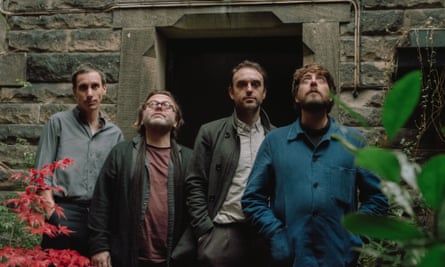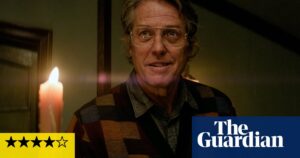For most bands, the main perk of living in a slightly rundown mansion-cum-artistic community on the city’s edge would be having licence to make an enormous racket. For Ex-Easter Island Head, says Benjamin Fair, it’s that “we get to play quietly”.
The four members of the Liverpool minimalists are sitting in Benjamin Duvall’s slate-grey bedroom/rehearsal space around the edge of their circular setup: guitars laid flat on keyboard stands, often with sticks wedged under the fretboard strings ready to create a giant reverberant twang, and mallets for hitting them on the floor; a drum kit deconstructed between the stations; haptic motors extracted from mobile phones primed to dance across the surface of the strings and cymbals. The band’s old amps are stacked in a corner behind Andrew Hunt, who joined in 2019 and suggested jettisoning them. “It eliminates any hum so you’re just hearing the strings,” he says.
When they perform, the first 10 minutes of their set shiver into being from near-total silence. “It’s easier to start quiet and get loud than blow people away and then try and get them to come with you into this quiet space,” says Hunt. For that opening spell, says Duvall, “we’re more listening than we are playing”.
Since 2009, this sensitive approach has steadily marked out Ex-Easter Island Head (EEIH) among the UK’s finest experimental acts. Their intricate sound and percussive approach to stringed instruments is hypnotic, eerily mechanical and shimmering, leading to performances alongside the likes of William Basinski, Colin Stetson and Rhys Chatham. The titles of their first five albums made their processes plain: Mallet Guitars One–Three; Large Electric Ensemble; Twenty-Two Strings. Their latest album follows suit, although its namesake is more mercurial. Norther is named after the strong wind that blows down the Wirral, which also became an instrument on the record. Duvall is a fiend for aeolian harps – literal wind instruments – and for Norther, they installed one on the roof of Bidston Observatory in Birkenhead, an artistic research centre and one of the highest points in the area, recording the sounds that blew through with a contact mic.
Duvall goes behind the partition to fetch the DIY harp – a tall, wooden telegraph-style pole with two small silver mixing bowls (the resonators), each suspended on three lengths of fishing line (the harp strings). Up at the observatory, the rocks have also been shaped by the wind, creating a “barren and mysterious” landscape, says Duvall. “The harp also has that mysterious thing because there’s no attack, no pluck, it just glides.” On the album, it floats over the band’s glistening microtonalities and rhythmic intricacies, creating a tingling, melancholy rush of a journey. Where their earlier records were pure documents of their live setup, this time they allowed themselves to act like “sculptors”, says Fair, not bound by what they could reproduce live.
This week in late October, Duvall is fresh from lecturing on aeolian instruments at Liverpool University. The fascination, he says, is that “it’s almost like hidden music – this is something we’ve been thinking about over the years. We’re coaching these tonalities and sounds out of instruments that are kind of otherworldly. Also, you’re opening yourself up to collaboration with something you don’t have full – or indeed any – control over.” The haptic motors are the same: quick to credit their friend Vitalija Glovackyte of Hyperdawn for giving them the idea, they let me run one over a cymbal, and the motor jumps around with skittish charm, producing a sound like metallic rainfall.
In another part of the album, the band sample their voices on phones then play the recordings through their guitar strings, which they replicate live. Each member enthusiastically picks apart their process and its significance. They’re fascinated by the intersection between old and new technology, and with taking unconventional approaches to their hardware. They kindly nod at my theory that their ethos might be one of harmony: the use of the wind suggesting a cooperation between man and weather; the old and new tech a similar one in the age of AI threatening creativity. “Aeolian instruments offer an interesting way of engaging with the climate crisis,” says Duvall. “They’re almost like antennae receiving weather data and reproducing it as sound.”

“To some extent what we do is based on a kind of ecological idea of arrangement, placing sounds in relation to each other where they can affect each other,” says Hunt. “And any time you’re doing something different with an instrument, you’re kind of saying: things can be done differently, you can change things structurally and have a significant impact.”
Some experimental music can be fiercely dry live, but EEIH are conscious of being proper performers, laying bare the connection between gesture and sounds that many listeners assume must be electronic (though the wind is played on a sampler). Their shows have caused listeners to break out in giggles, as when they sing into their phones. They’re not quite the Blue Man Group; perhaps more like the best science lesson you never had. “We always joke among ourselves afterwards: how dare they laugh!” says Jon Hering. “Getting a chuckle from the audience is not something every band would get.”
“In their early day, EEIH played serious serial minimalism with no wave leanings, but made it swing like rock’n’roll and look like a dignified laboratory experiment,” says Stewart Lee, a fan. “It was as beautiful to look at as it was to listen to, like some kind of dance piece for clockwork mannequins scored by executive desk toys. It was art, but your ass could follow it. If I had to convince some suspicious parent squares from the school gate that Wire magazine art-wank could move them and make them move I would take them to EEIH, but luckily none of them speak to me.”
Some fans are drawn to the mechanical side of things and want to inspect their gear afterwards, they say, while others are drawn to the emotion. The latter is a word that comes up a lot as we talk, a new frontier for a band conscious that they’ve been described as “boffiny”. When they formed in 2009, says Duvall, they were obsessed with a “minimalist mindset – holding a sound for a really long time, like La Monte Young or Steve Reich’s Two Pianos, process music. We’ve always looked at the music as having emotional heft, but it’s an emotion that’s quite slippery and shimmery. Some people get joyousness or melancholy from it.” By the time they made the self-evidently beautiful Norther they felt assured that the processes were integral enough that they could “go to town on the emotion”, says Hering.
“It also makes us a little bit less hermetically sealed,” says Duvall. “It invites a little bit more of the world in and that was something that was worth exploring at this point.”
Norther arrives eight years since their last record. At the risk of being impolite, EEIH seem unburdened by any pressure to reach vast audiences or clock up ever-greater successes. Part of that is the “cold, hard reality of day jobs”, says Duvall, a receptionist at Liverpool University who is branching out into lecturing; Hering teaches music to children with disabilities, often as part of the Royal Liverpool Philharmonic Orchestra; Fair works at the local arena; Hunt is the only full-time musician, with various projects (including releasing as Dialect on RVNG Intl, whose T-shirt he’s wearing today). But it’s also the result of using limited means, says Duvall. “When you’re working with a reduced palette, you want to make sure everything you’re saying with it is proper, you know?” Each new album necessitates a new setup, meaning the band is essentially learning a new language each time around – and they have no fixed roles.
One thing that keeps EEIH going during the lapses between releases is their work in education. They’ve led three massive school projects in recent years, including teaching pupils about aeolian instruments. It’s an education for them too, interacting with young people who haven’t yet formed fixed ideas about music, and being called on to explain their own approach. “Kids won’t be afraid to be like: ‘So you’re not on the telly?’” says Duvall. “‘You don’t make any money? No one’s making you doing this? Why are you doing it?’”
“That in itself is valuable for kids,” says Hunt. “Why do you do this weird thing? Oh, you just like doing it and sometimes you get paid? That’s a mind-blowing concept for some kids.”
Hering talks about the neglected concept of the “community musician” – how as with food, music is “a fabric of life that weaves through many different things. It can be within your schooling, your work, your social life, your community or city, in the streets. It’s really important for musicians too – not just ‘I get up on stage and do my thing and people clap’, but using my skills I’ve honed in all these different contexts and find what it can bring. I think that makes you a much more well-rounded musician and person.”
The band’s structure reflects this idea of the cooperative, as well as the rich potential of deep listening. “We’ve got these very spread-out parts that interlock to make something as a whole,” says Fair. “I get a sense of what I’m doing and how that forms part of something I can’t do by myself.”
“There’s always something doubling the bit of the rhythm you’re doing,” says Duvall. “Sometimes when you’re playing and you hear the other person’s sound, you lose ownership of your own. You don’t know where you end and the next person begins.”
Source: theguardian.com

















